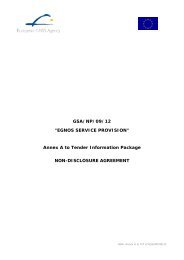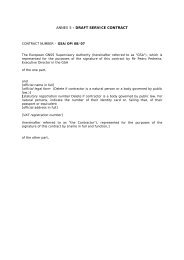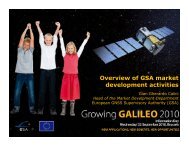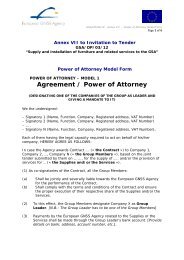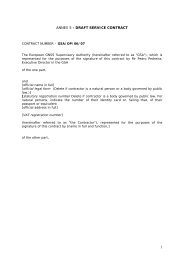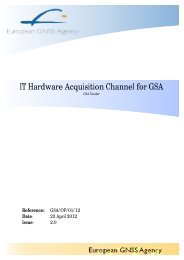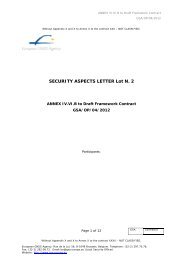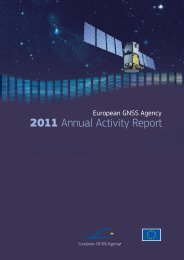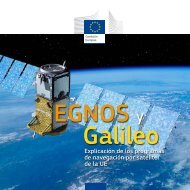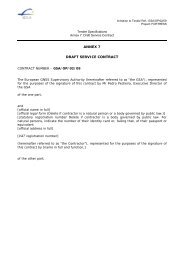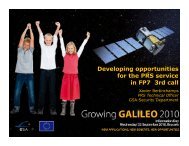EGNOS and Galileo - European GNSS Agency - Europa
EGNOS and Galileo - European GNSS Agency - Europa
EGNOS and Galileo - European GNSS Agency - Europa
Create successful ePaper yourself
Turn your PDF publications into a flip-book with our unique Google optimized e-Paper software.
Europe Direct is a service to help you find answersto your questions about the <strong>European</strong> Union.Freephone number (*):00 800 6 7 8 9 10 11(*) Certain mobile telephone operators do not allow access to 00 800 numbers or these calls may be billed.More information on the <strong>European</strong> Union is available on the Internet (http://europa.eu).Cataloguing data can be found at the end of this publication.Luxembourg: Publications Office of the <strong>European</strong> Union, 2012ISBN 978-92-79-23556-6doi:10.2769/32627© <strong>European</strong> Union, 2012Reproduction is authorised provided the source is acknowledged.Photos: © EC, © iStockphotoPrinted in BelgiumPrinted on recycled paper
Table of contentsForeword 5<strong>Galileo</strong> – A satellite navigation system for Europe 6Navigating by the stars, the 21 st century version 8How does satellite navigation work? 9Satellite navigation touches all aspects of our lives 10What services will <strong>Galileo</strong> offer us? 11<strong>Galileo</strong> – Signalling for you 12Countdown to lift-off – Creating the <strong>Galileo</strong> system step by step 14Signals from space made even more accurate 16<strong>EGNOS</strong> – A boost to satellite navigation in Europe 18Why we need a <strong>European</strong> boost to satellite navigation 19<strong>EGNOS</strong> – Success stories 20
5ForewordSteering by the stars – 21 st century styleA farmer st<strong>and</strong>s in a field deciding how many chemicals tospray on his crops, while many kilometres away from dry l<strong>and</strong>,a mariner falls overboard into a choppy sea – the one thingthey both have in common is their dependence on satellitenavigation systems.You thought SatNav was mainly for finding your way to yourdestination? That’s certainly one use that simplifies our dailylives. But whether it’s man-overboard systems that showwhere someone falls into the water from a boat or theenvironmental protection that precision farming offers, thecreation of different ways in which satellite navigationsystems can improve our lives is limited only by ourimaginations.It’s the start of a new age in satellite navigation as <strong>Galileo</strong>rolls out its initial phase of 18 satellites in 2014 <strong>and</strong> its fulloperation phase in 2018, with 30 satellites. Together withreinforced American <strong>and</strong> Russian systems, along with otheremerging systems, <strong>Galileo</strong> will ensure that satellite navigationsystems are more accurate, more reliable <strong>and</strong> more securethan ever before.Read on to find out how the navigation systems which we useto go about our daily lives in safety <strong>and</strong> comfort also feed intocommerce, innovation <strong>and</strong> environmental protection. See howthe various elements come together to make a system that isfit for our 21 st century needs.This booklet takes you on a voyage of discovery into the heartof Europe’s satellite navigation programmes – <strong>EGNOS</strong> <strong>and</strong><strong>Galileo</strong>. We take you through how the systems work, whatelements go into making them <strong>and</strong> what they offer or willoffer us all.
8Navigating by the stars,the 21 st century versionFor thous<strong>and</strong>s of years man has looked to the skyto navigate his way. This guidance from space takeson a new form with the recent development ofsatellite navigation systems.By early 2020 there will be more navigation satellites in thesky than ever before. The <strong>European</strong> Union is powering aheadwith the <strong>European</strong> Geostationary Navigation Overlay Service(<strong>EGNOS</strong>, already operational) <strong>and</strong> its <strong>Galileo</strong> programme.Meanwhile, pioneers in the field of Global NavigationSatellite Systems (<strong>GNSS</strong>), the GPS <strong>and</strong> GLONASS systems,are being modernised.Other countries are building their own global/regionalsystems, introducing more frequencies, signals <strong>and</strong> potentialfor <strong>GNSS</strong>. These advances will boost signal availability,accuracy <strong>and</strong> reliability, responding to the ever-increasingdem<strong>and</strong>s of the user.Building on existingsystemsLike the internet, satellitenavigation has become atechnology on which wedepend in our daily lives.The <strong>European</strong> Union hasdevoted a lot of effort tobuilding its own globalnavigation satellite system,under a programme called<strong>Galileo</strong>. Its impact on the<strong>European</strong> economy,capacity to stimulate jobs<strong>and</strong> technological knowhow,along with the myriadof applications based onits services, is significant.<strong>Galileo</strong> opens up a wholenew market for <strong>European</strong>entrepreneurs who wish tocreate innovative productsusing <strong>Galileo</strong>.<strong>Galileo</strong> can work with theAmerican GPS system forsome of its services so wecan be sure of evengreater precision <strong>and</strong>availability of signalsthanks to the highernumber of satellites usedto compute position.Information transmitted bythe satellites back to earthcan be made more preciseby regional Satellite-Based AugmentationSystems (SBAS) such as<strong>EGNOS</strong> for Europe – <strong>and</strong>WAAS for North America.<strong>EGNOS</strong> is alreadyoperational <strong>and</strong> availablefor free; all the user needsis an <strong>EGNOS</strong>-enabledreceiver.
11What services will <strong>Galileo</strong> offer us?Pilots, sailors, our emergencyservices, from industry toagriculture, for professionalor leisure use: <strong>Galileo</strong> hassomething for everybody.<strong>Galileo</strong> will provide five mainservices. The first three that willbe available in 2014 are:Open Service (OS): this will beavailable to everyone free of charge<strong>and</strong> will provide anyone, with the rightreceiver, with improved signals for timing <strong>and</strong>location. This will stimulate innovation in exploring how theservice can be used.Search <strong>and</strong> Rescue (SAR): <strong>Galileo</strong> has a unique twist onthis service. It will help detect emergency signals, relayingthem immediately to national emergency services. Distressmessages will be received in real time: now the averagewaiting time is an hour. Moreover, the sender will receive aconfirmation message that his/her distress signal has beenreceived <strong>and</strong> help is on the way. Lastly, alerts will beprecisely located to within a few metres: now it can beup to five kilometres in the most remote areas.Public Regulated Service (PRS): this restricted-accessservice provides information on location <strong>and</strong> time to certainusers, like the police, ambulance services or peacekeepingforces who require high levels of signal reliability <strong>and</strong>continuity. This service will continue to be provided evenwhen the Open Service is switched off (for example if it isbeing used in a terror attack) or falls under attack(spoofing, jamming).The remaining two services that will be provided with fullconstellation in 2018 are:Commercial Service (CS): this will combine two encryptedsignals for increased accuracy for use in industries such asmining, surveying or mapping. It is a fee-based service.Safety-of-Life (SoL) Service: <strong>Galileo</strong> will contribute tointegrity monitoring services aimed at users of safety-of-lifeapplications in compliance with international st<strong>and</strong>ards.It will be used in sectors where life is at stake such as in airor maritime transport. For example, it will make en-routenavigation <strong>and</strong> precision approaches more accurate thanever, even in poor weather conditions <strong>and</strong> where there areno ground-based navigation aids.
12<strong>Galileo</strong> – Signalling for youEurope's globalnavigation satellite systemwill bring a huge range of public<strong>and</strong> commercial opportunities.Some potential applications have beenidentified, but when it comes to harnessingthe full potential of <strong>Galileo</strong>, innovativeentrepreneurs <strong>and</strong> researchers have theopportunity to improve the waywe work <strong>and</strong> play.Below are just a few examples of how<strong>Galileo</strong> will respond to increasingneeds of the user.Location based servicesDigital cameras, mp3 players, your mobilephone or laptop – all these could be fittedwith accurate position signalling receivers.Dedicated positioning devices will help usfind our way in an increasingly busy world.TransportBy plane, train or automobile, <strong>Galileo</strong> willmake transport more comfortable <strong>and</strong> saferthan ever – whether it is by identifying trafficjams or helping the aviation industry,your transport will be enhanced by <strong>Galileo</strong>.Energy resourcesHigh-resolution surveys of possible drilling siteswill show if a potential site is geologically stable.Repairs to the electricity grid can be perfectlysynchronised. Improvements to navigation <strong>and</strong> timesynchronisation will mean energy transport <strong>and</strong> distributionis more efficient than ever. <strong>Galileo</strong> – energising Europe.FinanceSecure data transfer, authenticity <strong>and</strong> confidentiality, data integrity– <strong>Galileo</strong> will play its part in the protection of data by using the latestauthentication techniques.
13Civil engineeringThis is one domain that has zero margin for error so the accuracy <strong>and</strong> reliabilityoffered by <strong>Galileo</strong> has the potential to decrease costs <strong>and</strong> boost productivity.<strong>Galileo</strong> – constructing Europe.AgricultureThe positioning signals <strong>and</strong> high-resolution imagery <strong>Galileo</strong>offers will help farmers customise their treatment of theircrops <strong>and</strong> l<strong>and</strong>, field by field.FisheriesImproved navigation tools <strong>and</strong> better communication– just part of what <strong>Galileo</strong> will offer the fishingindustry.EnvironmentMapping the oceans, measuring polar ice <strong>and</strong>tracking the movement of animals all feedinto protecting the natural world.The benefits to the environment of theaccurate, sensitive tracking <strong>and</strong> monitoringsystems <strong>Galileo</strong> offers are numerous.Time referenceThe precision of time information <strong>Galileo</strong>offers will be useful in manyapplications. From experiments thatdepend on accuracy to the millisecond,to authenticated timing <strong>and</strong> its rolein banking <strong>and</strong> the stock market, <strong>Galileo</strong>will offer users reliable security.
14Countdown to lift-offCreating the <strong>Galileo</strong> systemstep by stepStarted in the 1990s, a series of steps are beingtaken to make <strong>Galileo</strong> fully operational by 2018In 2008, as part of the in-orbit validation phase, the <strong>European</strong>Space <strong>Agency</strong> (ESA) awarded contracts to certain companiesto work on the in-orbit validation phase of <strong>Galileo</strong>. Thisincluded support services, the building <strong>and</strong> launch of foursatellites <strong>and</strong> the related ground infrastructure <strong>and</strong> theoperation of those satellites once in orbit.In 2010, 2011 <strong>and</strong> 2012, the ESA, acting on behalfof the <strong>European</strong> Commission, awarded contracts for the fulloperational capability phase of <strong>Galileo</strong>. The contracts forengineering support, the building of fourteen satellites,the launch of twelve satellites <strong>and</strong> operations were awardedin 2010.The contracts for ground control <strong>and</strong> ground mission wereawarded in 2011.In 2012, additional contracts were awarded for the building ofanother eight satellites <strong>and</strong> to secure the launch of an extra10 satellites. This brings the current capacity to 26 satellitesin orbit. The last four satellites <strong>and</strong> their launches still needto be procured.
15Up <strong>and</strong> running in two phases1. 2.In-orbit validationTesting <strong>and</strong> operating four satellites <strong>and</strong> their groundsystems makes up the first phase. October 2011 sawthe launch of the first two satellites. Two more aredue to follow in the second half of 2012.Full operational capacityThe second phase will initially see 18 satellites inorbit in 2014. Three initial services will start to beprovided as of then (OS, SAR Service <strong>and</strong> PRS).The remaining satellites will be launched afterwards,totalling 30 satellites including 6 spares in orbit in2018, when the remaining services will be provided(CS <strong>and</strong> SoL Service).A fantasticopportunityfor growthin Europe<strong>Galileo</strong> <strong>and</strong> <strong>EGNOS</strong> areestimated to generatecumulative socio-economicbenefits worth around €90billion to the EU’s economyover the period 2010-27.Jobs <strong>and</strong> business arebeing created forcompanies of sizes, whilespin-offs, coming out ofthe technology beingdeveloped, can be used byentrepreneurs <strong>and</strong>researchers outside thespace industry.The impact of the satellitesystem will give a directboost to the transportsector in all its forms.The <strong>European</strong>Commission’s aim to grantcitizens <strong>and</strong> businessesaccess to the benefits ofthe new satellitenavigation system is ontarget. With all thepossible applications thiscould have, <strong>Galileo</strong> is setto spark a new wave ofinnovation.
16Signals from space madeeven more accurateSatellite navigation signals are improved by what are knownas Satellite-Based Augmentation Systems (SBAS).To get a better idea: someone using a GPS receiver thathasn’t been augmented can only be sure of his or herposition to within 17 metres. An augmented signal can tellyou where you are to within three metres.Europe already has its own SBAS called the <strong>European</strong>Geostationary Navigation Overlay Service (<strong>EGNOS</strong>).This can work with both GPS <strong>and</strong> <strong>Galileo</strong>. All SBAS systemsare interoperable so that users – in particular airplanes –can use them wherever they are.This improvement is useful for many sectors <strong>and</strong> vital forthe aviation industry – airplanes using satellite navigationfor en-route <strong>and</strong> precision approaches need that level ofprecision. They also need an integrity function which notifiesthem, within a few seconds, when the underlying<strong>GNSS</strong> is faulty.
17Where can we see the difference?Aviation – Safer, cheaper <strong>and</strong> more efficient, <strong>EGNOS</strong> provides the accuracy neededto guide pilots safely during their flight <strong>and</strong> onto runways. It makes it possible forlarger passenger airplanes to l<strong>and</strong> at regional airports that are often not equippedwith ground-based navigation aids.Road – The improvements to the positioning accuracy <strong>EGNOS</strong> brings, makesit possible for more trains to use our infrastructure <strong>and</strong> for cars to find shorter,more fuel-efficient routes. Knowing exactly where each vehicle is letscompanies improve their logistics. It also means the police <strong>and</strong> otheremergency services get to where they are needed, faster.Agriculture – Saving farmers money, helping the environment <strong>and</strong>boosting crop yields, <strong>EGNOS</strong> means precision agriculture benefits not onlyfor those working on the l<strong>and</strong>, but for the l<strong>and</strong> itself. Using aerial imagers<strong>and</strong> other tools, it is now possible to work out just the right amount ofseeds to sow <strong>and</strong> how much fertiliser to use, on a field-by-field basis.Location-based Services – From our cars to our gadgets, thepersonal navigation devices we use benefit from the improved accuracy<strong>EGNOS</strong> provides. You might want to locate a friend nearby or you mightneed to be airlifted off a mountain – life-saving or just lifestyle, this extraaccuracy makes all the difference.Maritime – Port operations <strong>and</strong> coast guards, offshore exploration <strong>and</strong>fisheries management; the service <strong>EGNOS</strong> is bringing improves every aspectof maritime operations.
18<strong>EGNOS</strong> – A boost to satellitenavigation in EuropeBy correcting errorssuch as those linked toionospheric disturbances, SBAS, likethe <strong>European</strong> Geostationary NavigationOverlay Service (<strong>EGNOS</strong>), make informationreceived from <strong>GNSS</strong> systems like <strong>Galileo</strong> <strong>and</strong>GPS even more accurate.<strong>GNSS</strong> systems alone do not meet the necessaryoperational requirements set by the civil aviationauthorities <strong>and</strong> the improved accuracy is alsobeneficial to all other uses of <strong>GNSS</strong> systems.As they are interoperable, SBAS systemshelp provide continuous coverageacross the globe.WAAS<strong>EGNOS</strong>SDCMGAGANThe <strong>European</strong> Geostationary NavigationOverlay Service (<strong>EGNOS</strong>) covers Europe <strong>and</strong> beyond.MSASThe USA uses the Wide Area Augmentation System (WAAS).Japan is covered by its Multi-functional SatelliteAugmentation System (MSAS).India also has its own SBAS, GAGAN, which coversthe Indian subcontinent.Also active in the field, covering the Russian Federation, is the RussianGLONASS System of Differential Correction & Monitoring – SDCM.All the SBAS are interoperable, so with the same receiver, users can benefitfrom augmentation of satellite navigation everywhere in the world.
19Why we need a <strong>European</strong> boostto satellite navigationOnce fully established, improvements to the accuracy of satellite information willopen up GPS <strong>and</strong> <strong>Galileo</strong> to a wider range of uses <strong>and</strong> applications.Three services are provided by <strong>EGNOS</strong>:Open ServiceLaunched in October 2009,this is offered for free toanyone with a receivercompatible with satellitebasedaugmentationsystems.Safety-of-lifeServiceThis service was launched inMarch 2011 for civilaviation, providing anindispensable warning tousers within six seconds inthe case of a GPS (<strong>and</strong> soon<strong>Galileo</strong>) malfunction. Whenlives are potentially at stakesuch as in aviation, thiswarning is essential.Commercial ServiceAll the information collected<strong>and</strong> generated by <strong>EGNOS</strong> isalso available through aground network, meaningthat in situations wheresatellite signals are blockedor disturbed, the informationcan still be accessed. This isespecially relevant in densecities where tall buildingscan block GPS signals.



